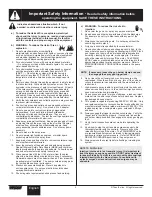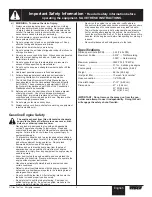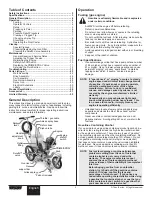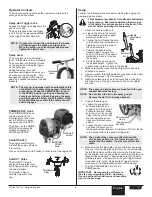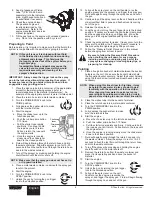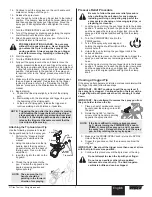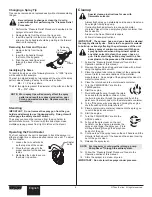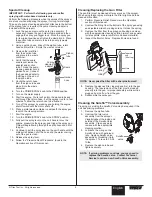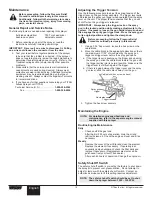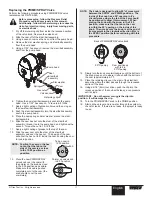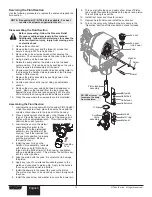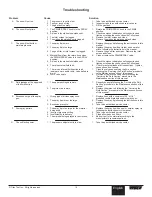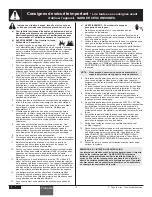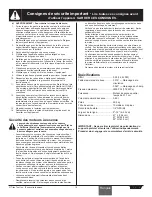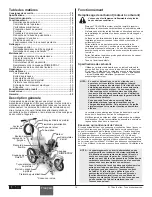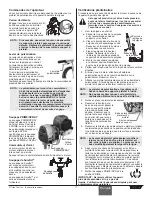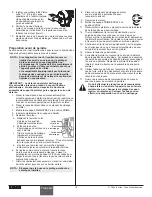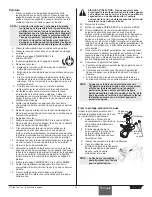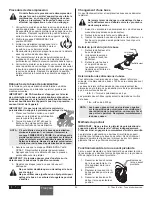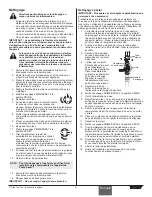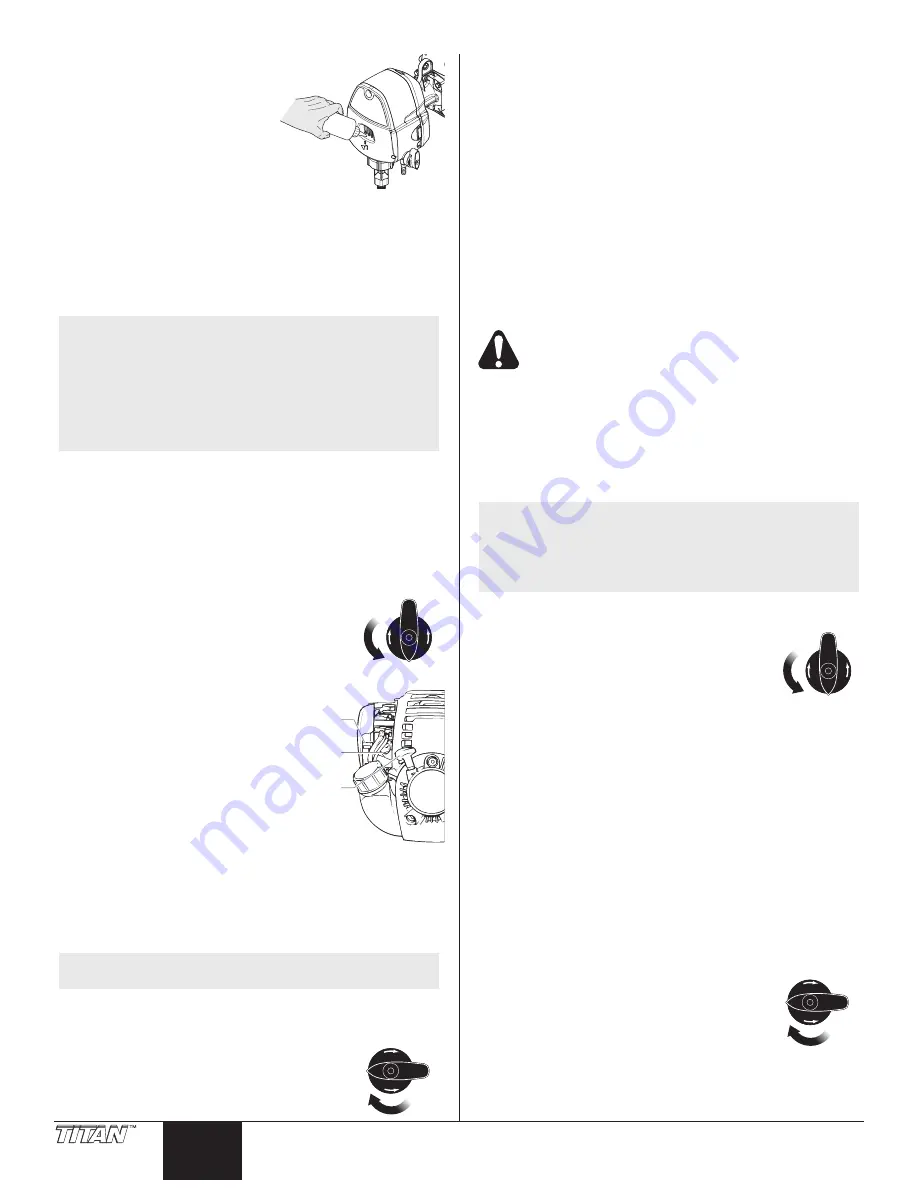
English
6
© Titan Tool Inc. All rights reserved.
8. Squirt a teaspoon of Piston
Lube™ (P/N 314-480, sold
separately) into the indicated
area. Light household oil can
be substituted if necessary.
9. Check the engine oil level.
The gasoline engine oil
level is determined by the
manufacturer. Refer to the
engine manufacturer’s service
manual (supplied).
10. Fill the gas tank on the engine with unleaded gasoline
only. Do not mix the gasoline with 2-cycle oil.
Preparing to Paint
Before painting, it is important to make sure that the fluid in the
system is compatible with the paint that is going to be used.
NOTE: If this unit is new, it is shipped with test fluid
in the fluid section to prevent corrosion during
shipment and storage. This fluid must be
thoroughly cleaned out of the system before you
begin spraying.
Incompatible fluids and paint may cause the
valves to become stuck closed, which would
require disassembly and cleaning of the
sprayer’s fluid section.
IMPORTaNT: always keep the trigger lock on the spray
gun in the locked position while preparing the system. If
necessary, loosen the gun holder clamp knob and then
engage the spray gun trigger lock.
1. Place the siphon tube into a container of the appropriate
solvent for the material being sprayed (refer to
recommendations of the material manufacturer). An
example of the appropriate solvent is water for latex paint.
2. Place the return hose into a metal waste container.
SPRAY
P
R
IM
E
3. Turn the PRIME/SPRAY knob to the
PRIME position.
4. Fully depress the pusher stem to make
sure the inlet ball is free.
5. Start the engine:
Prime
bulb
Starter
rope
Choke
lever
a. Move the choke lever up to the
full choke position.
b. Push the rubber prime button
7-10 times.
c. Pull the starter rope rapidly
and firmly. Continue to hold
the rope as you let it return.
Pull and return the rope until
the engine starts.
d. Once the engine is running,
slowly move the choke lever
down to the closed position.
6. Fluid will begin flowing through the return hose and into
the waste container. Allow the sprayer to run for 15–30
seconds to flush the test fluid out through the return hose
and into the waste container.
7. Turn off the sprayer by pressing and holding the engine
shutoff switch until the motor shuts off.
NOTE: Make sure that the spray gun does not have a tip
or tip guard installed.
8. Place a metal waste container underneath the spray gun
to catch the solvent.
9. Start the engine.
SPRAY
PR
IM
E
10. Turn the PRIME/SPRAY knob to the
SPRAY position.
11. Unlock the gun by turning the gun trigger
lock to the unlocked position.
12. Fully pull the spray lever on the cart handle to rev the
engine, pressurize the sprayer, and trigger the spray gun.
Fluid will begin flowing through the spray hose and out of
the gun.
13. Continue to pull the spray lever on the cart handle until the
old solvent/test fluid is gone and fresh solvent is coming
out of the gun.
14. Release the spray lever.
15. Lock the gun by turning the gun trigger lock to the locked
position. If necessary, loosen the gun holder clamp knob
and then engage the spray gun trigger lock. Move the
spray gun to its original position and tighten the clamp
knob.
16. Check the entire system for leaks. If leaks occur, turn the
sprayer off and follow the “Pressure Relief Procedure” in
this manual before tightening any fittings or hoses.
17. Follow the “Pressure Relief Procedure” in this manual
before changing from solvent to paint.
Be sure to follow the Pressure Relief Procedure
when shutting the unit down for any purpose,
including servicing or adjusting any part of the
spray system, changing or cleaning spray tips, or
preparing for cleanup.
Painting
1. Place a five gallon bucket of material between the bucket
holders on the cart. Make sure the bucket holders hold
the five gallon bucket securely. Adjust the bucket holders
using the thumb screw located underneath each holder, if
necessary.
NOTE: When using this line striper for first time, it may
be helpful to use water in place of paint to gain
familiarity with the operation of the line striper.
after changing from water to paint, test spray
several lines on cardboard, roofing felt, or rosin
paper before striping to ensure correct line width.
2. Place the siphon tube into the bucket of material.
3. Place the return hose into a metal waste container.
SPRAY
P
R
IM
E
4. Turn the PRIME/SPRAY knob to the
PRIME position.
5. Fully depress the pusher stem to make
sure the inlet ball is free.
6. Start the engine:
a. Move the choke lever up to the full choke position.
b. Push the rubber prime button 7-10 times.
c. Pull the starter rope rapidly and firmly. Continue to hold
the rope as you let it return. Pull and return the rope until
the engine starts.
d. Once the engine is running, slowly move the choke lever
down to the closed position.
7. Fluid will begin flowing through the return hose and into
the waste container. Allow the sprayer to run for 15–30
seconds to flush the test fluid out through the return hose
and into the waste container.
8. Turn off the sprayer by pressing and holding the engine
shutoff switch until the motor shuts off.
9. Remove the return hose from the waste container and
place it in its operating position above the bucket of
material.
10. Start the engine.
SPRAY
PR
IM
E
11. Turn the PRIME/SPRAY knob to the
SPRAY position.
12. Unlock the gun by turning the gun trigger
lock to the unlocked position.
13. Fully pull the spray lever on the cart
handle to rev the engine, pressurize the
sprayer, and trigger the spray gun. Fluid will begin flowing
through the spray hose and out of the gun.


